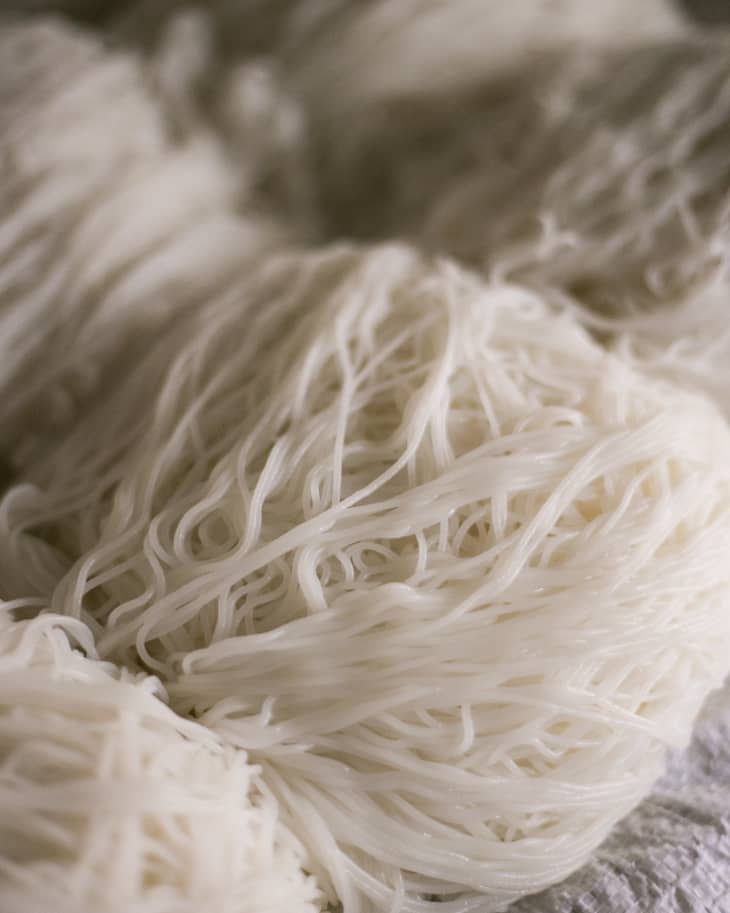A Guide to Vietnamese Noodles
If you’ve been to Vietnam or even just the noodle aisle of your neighborhood Asian market, you might have been overwhelmed by the sheer variety of noodles available. Which ones are good for a stir-fry? Which should you buy fresh, and which are better dried? What even is the difference between all of those white, gray, translucent, and yellow noodles?
Here’s a short guide to help you navigate the noodle aisle, so you can try your hand at a dish from the vast repertoire of Vietnamese cuisine.
Rice Vermicelli Noodles (Bún)
What do they look like?
Bún (pronounced “boon”) is a thin white noodle made from rice. Fresh noodles are jiggly and sticky, and dried noodles are very white.
How can I eat them?
These noodles are everywhere in Hanoi, served blanched in the bottom of big bowls of bún riêu, a meat, tomato, and fried tofu soup commonly eaten for breakfast; rolled into spring rolls (ném); and served next to grilled pork in bún chả or fried tofu in bún đậu with herbs and different dipping sauces. They come in different thicknesses, but the difference is miniscule.
Should I buy them fresh or dried?
These noodles are best fresh, so look for them in the refrigerated section, often translated into English as rice vermicelli. If you can’t find them, try the dried noodles aisle and follow the directions on the bag.
Other Southeast Asian cuisines use rice vermicelli, so there’s no need to buy only Vietnamese noodles. Just be careful to buy rice vermicelli, as vermicelli noodles can also be made from mung beans.
Recipes with Rice Vermicelli Noodles
- Bún Chay (Vietnamese Vegetarian Noodle Salad)
- Gơi Chay (Vietnamese Vegetarian Salad)
- Homemade Vietnamese Spring Rolls
Rice Sticks (Bánh Phở)
What are they?
You know these thick white rice noodles from the trendy beef or chicken noodle soup, phở, which is possibly Hanoi’s most famous cultural export. While the soup is known for its broth base that’s traditionally simmered for hours, it’s actually named after the fettuccine-shaped rice noodles that make it a filling, full meal.
How can I eat them?
Phở noodles aren’t just for soup; they’re often stir-fried as well in dishes like phở xào. The flexible white sheets of processed rice that are cut into strips to make the noodles can also be used to make phở cuốn, rice noodle rolls filled with sautéed beef and herbs dipped in sauce. The noodle sheets are also used in phở chiên, where they are cut into squares, deep-fried, and served plain with dipping sauce or smothered in sautéed beef and greens — it’s like eating delicious, sinful little pillows; crunchy on the outside and chewy in the center.
Should I buy them fresh or dried?
This depends on your use. After a 15 to 20 minute soak in warm water and a quick blanch, dried noodles can go into soup. Soaked until still “al dente,” they soak up sauces well in stir-fries — just be careful not to overcook them, or they get mushy.
Bánh phở might also be labeled “rice sticks” or “chantaboon,” the Thai name, in the market. You can also substitute dried pad Thai noodles. Fresh or refrigerated phở cuốn, though, is a necessity. Don’t confuse it with dry rice paper, which is much thinner and inflexible until brushed with water or vinegar, but a decent substitute.
Recipes with Wide Rice Noodles
Other Types of Vietnamese Rice Noodles
Bún and phở are by far the most common noodles I’ve seen in Hanoi. Here are a few other types and their uses:
Egg Noodles (Mì)
Think of these as Chinese lo mein. They’re yellow egg noodles, and I’ve only seen them in stir-fries such as the delicious mì xào hải sản, fried noodles with squid and shrimp, and mì xào bò, the same but with beef. Substitute lo mein, chow mein, or any other spaghetti-sized egg noodle. Since you’re stir-frying, buying them dried would be fine, but they’ll likely be easier to find than other types of noodles since they’re used in many Asian kinds of cuisine.
Glass Noodles (Miến)
These thin and round or narrow and flat noodles are really cool looking when cooked! They start off gray and mostly opaque, but they’re clear, slippery, and extra flexible when fully cooked. They’re made of mung beans and often called mung bean threads, glass noodles, cellophane noodles, or vermicelli, not to be confused with rice vermicelli, or bún (above). They’re often added to fried or fresh spring rolls after being soaked in hot water until they’re still a bit chewy, or served in a chicken soup.
Tapioco and Rice Flour Noodles (Bánh Canh)
These thick white noodles made of tapioca flour or a mix of tapioca flour and rice are similar to Japanese udon noodles. They’re used in different soups and are more common in the center and south of Vietnam that in the north.
Instant Noodles
Haters gonna hate, but instant noodles in Vietnam are much better (and even cheaper) than Top Ramen noodles. They’re widely eaten for breakfast or soaked and stir-fried with vegetables, meat, and egg for a more filling meal. Try Cung Dinh brand on its own,
doctor up your own bowl
Next time you go to an Asian market, pick up a couple different noodles and try a new dish! If you’re really trying to be Vietnamese, you would eat noodles only for breakfast or lunch, but we won’t tell if you eat them for dinner.
What’s your favorite way to eat noodles?
